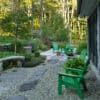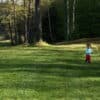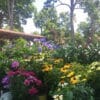Ironically enough, it’s the dead of winter when making changes to your landscape is easy to envision, and, with a bit of snow, to mock up.
Taking advantage of the winter landscape to try out some design changes for next year. Photo: Steve Jonas.
Last week I spoke on air with Bob Tanem, an engaging San Francisco radio interviewer, about our new book on the Toronto Music Garden. He asked a great question: “What does the Music Garden look like in winter?” I was happy to reply, “It looks great no matter what the season because the structure is good.” Even if the grasses in the Courante are beaten down by high winds or snowfall, the garden’s paths still entice you to follow them up and down the three hills, to discover the Allemande’s inward-turning squirrel trails that lead to quiet sitting stones beneath white-barked birch trees, or to skip down steps in the lyre-shaped Gigue. Indeed, every design we do here at JMMDS possesses a winter-ready layout.
The Music Garden’s grasses in winter. Photos: L: Mungo; R: Janet Davis.
As I sit here writing this, a snowstorm swirls outside my windows. The landscape is swiftly becoming an abstraction of itself. Instead of seeing all the details of a garden in bloom, all I see now is a blanket of white. This is the moment to get the composition right: to imagine installing a tree here or adding a grouping of shrubs there. It’s also the perfect time, not only to visualize, but also to actually mock up, changes to a bed line by drawing it out in the snow.
Before & After: Mocking up a terrace and wider garden bed using snow. Photos: Steve Jonas.
Don’t worry if you live in a climate without snow–you can still see your landscape in the abstract by simply squinting. Try it with the images below. You’ll find that the different elements of your garden lose clarity and look fuzzy. Tall trees become large blobs of green and vertical lines; a flowerbed becomes a thick line of color; lawn becomes field; walls turn into dark lines running across the landscape. The view you take in becomes an abstract painting of soft textures, dabs of color, looming volumes, and curving or straight lines that may be layered to suit your aesthetic needs. When you see the landscape as a blur, you focus less on the details and more on the overall forms in front of you. You can mentally rearrange blocks of elements with ease, imagining adding a splash here and removing a blob there. Through abstraction, you’ll create a structure for your garden that looks great, no matter what the season.
Grasses and trees become blocks of color and form when you see them in the abstract. Photos from Home Outside: Creating the Landscape You Love, p. 172 & 173.
Photos: Genevieve Russell/StoryPortrait Media; Design: Donna Bone, Design With Nature.










Toronto’s Music Garden always looks wonderful. I am one of the guides who leads tours of the Music Garden. It is a privledge to do so and I always encourage people to visit the garden in the winter.
After summer solstice, we visited and listened our way through the Courante, the Allemande and the Gigue at St. Lucia’s festival in early December. The sounds of early Winter were an extra gift, with a still small voice. The unfolding discovery at each turn left me convinced that for everything there is a season — especially if JMMDS has its hand in setting the bones of the garden.
To visit the Garden in but one season is only 1/4th of the whole. It is worth the return trips to see the Toronto Music Garden as if for the first time.